Comprehensive Review of the IOM Nursing Report: Key Findings
VerifiedAdded on 2022/08/27
|7
|1472
|17
Report
AI Summary
This report provides a comprehensive review of the Institute of Medicine (IOM) nursing report, focusing on its key recommendations and their implications for the future of nursing and healthcare. The report analyzes the IOM's four key messages, emphasizing the importance of nurses practicing to the full extent of their education, achieving higher levels of training and education, collaborating with other healthcare providers, and utilizing better data collection methods. It discusses the role of the Robert Wood Johnson Foundation and the impact of the Affordable Care Act. The analysis also covers state-based action coalitions and initiatives aimed at improving nursing education, cultural competency, and healthcare delivery. The report highlights barriers to advancement and concludes with a summary of the report's significance in transforming the healthcare landscape and strengthening nursing care.
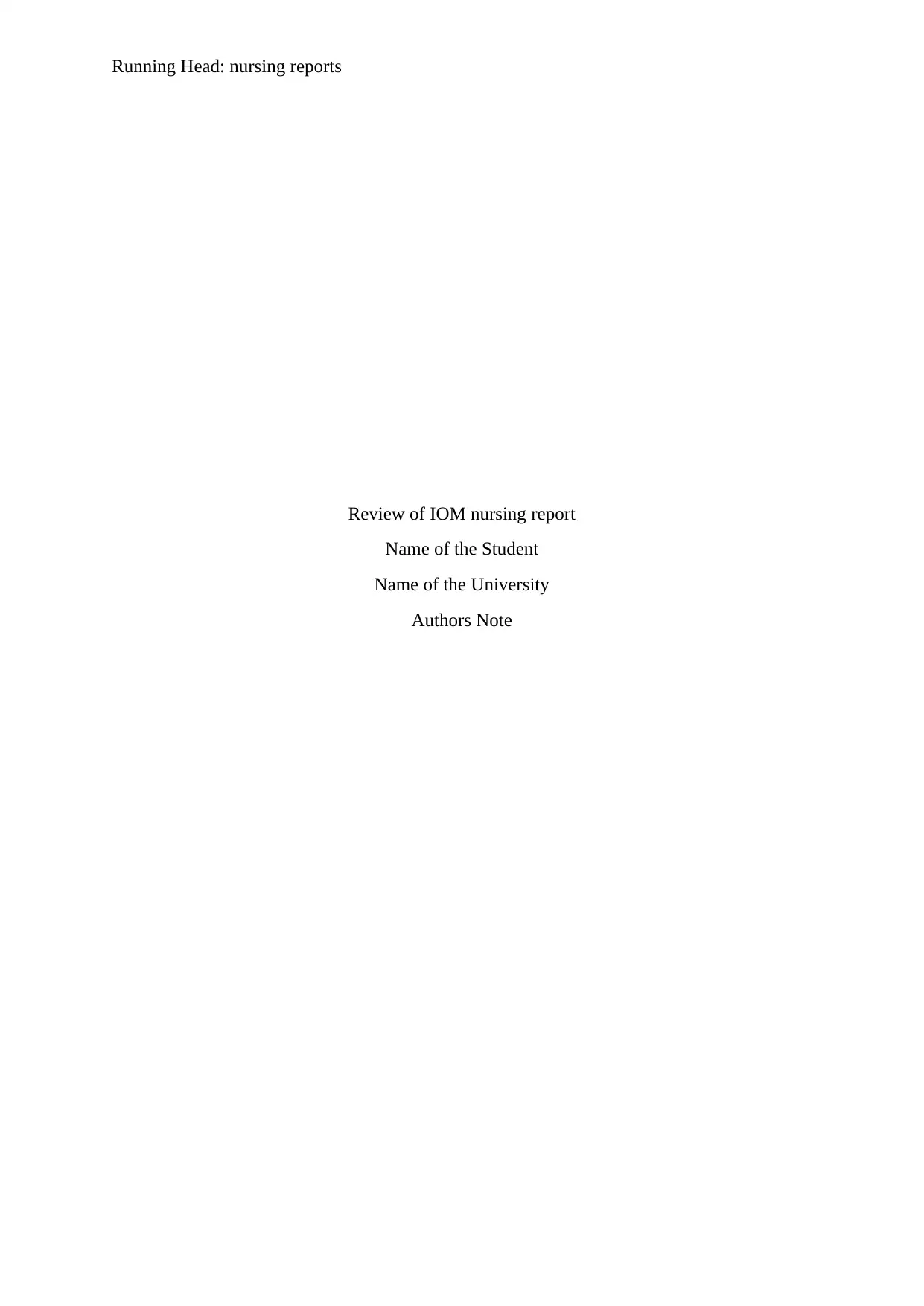
Running Head: nursing reports
Review of IOM nursing report
Name of the Student
Name of the University
Authors Note
Review of IOM nursing report
Name of the Student
Name of the University
Authors Note
Paraphrase This Document
Need a fresh take? Get an instant paraphrase of this document with our AI Paraphraser
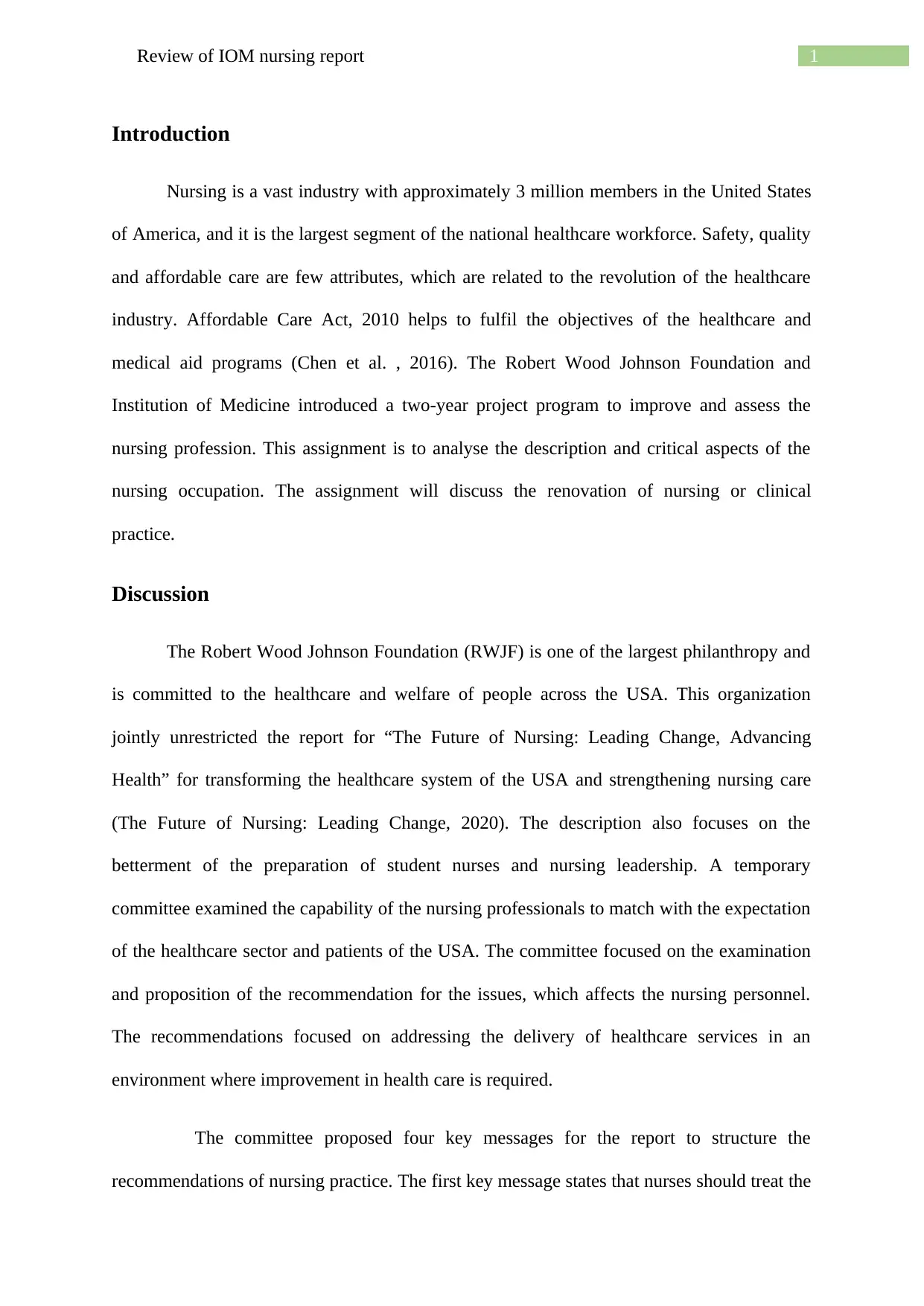
1Review of IOM nursing report
Introduction
Nursing is a vast industry with approximately 3 million members in the United States
of America, and it is the largest segment of the national healthcare workforce. Safety, quality
and affordable care are few attributes, which are related to the revolution of the healthcare
industry. Affordable Care Act, 2010 helps to fulfil the objectives of the healthcare and
medical aid programs (Chen et al. , 2016). The Robert Wood Johnson Foundation and
Institution of Medicine introduced a two-year project program to improve and assess the
nursing profession. This assignment is to analyse the description and critical aspects of the
nursing occupation. The assignment will discuss the renovation of nursing or clinical
practice.
Discussion
The Robert Wood Johnson Foundation (RWJF) is one of the largest philanthropy and
is committed to the healthcare and welfare of people across the USA. This organization
jointly unrestricted the report for “The Future of Nursing: Leading Change, Advancing
Health” for transforming the healthcare system of the USA and strengthening nursing care
(The Future of Nursing: Leading Change, 2020). The description also focuses on the
betterment of the preparation of student nurses and nursing leadership. A temporary
committee examined the capability of the nursing professionals to match with the expectation
of the healthcare sector and patients of the USA. The committee focused on the examination
and proposition of the recommendation for the issues, which affects the nursing personnel.
The recommendations focused on addressing the delivery of healthcare services in an
environment where improvement in health care is required.
The committee proposed four key messages for the report to structure the
recommendations of nursing practice. The first key message states that nurses should treat the
Introduction
Nursing is a vast industry with approximately 3 million members in the United States
of America, and it is the largest segment of the national healthcare workforce. Safety, quality
and affordable care are few attributes, which are related to the revolution of the healthcare
industry. Affordable Care Act, 2010 helps to fulfil the objectives of the healthcare and
medical aid programs (Chen et al. , 2016). The Robert Wood Johnson Foundation and
Institution of Medicine introduced a two-year project program to improve and assess the
nursing profession. This assignment is to analyse the description and critical aspects of the
nursing occupation. The assignment will discuss the renovation of nursing or clinical
practice.
Discussion
The Robert Wood Johnson Foundation (RWJF) is one of the largest philanthropy and
is committed to the healthcare and welfare of people across the USA. This organization
jointly unrestricted the report for “The Future of Nursing: Leading Change, Advancing
Health” for transforming the healthcare system of the USA and strengthening nursing care
(The Future of Nursing: Leading Change, 2020). The description also focuses on the
betterment of the preparation of student nurses and nursing leadership. A temporary
committee examined the capability of the nursing professionals to match with the expectation
of the healthcare sector and patients of the USA. The committee focused on the examination
and proposition of the recommendation for the issues, which affects the nursing personnel.
The recommendations focused on addressing the delivery of healthcare services in an
environment where improvement in health care is required.
The committee proposed four key messages for the report to structure the
recommendations of nursing practice. The first key message states that nurses should treat the
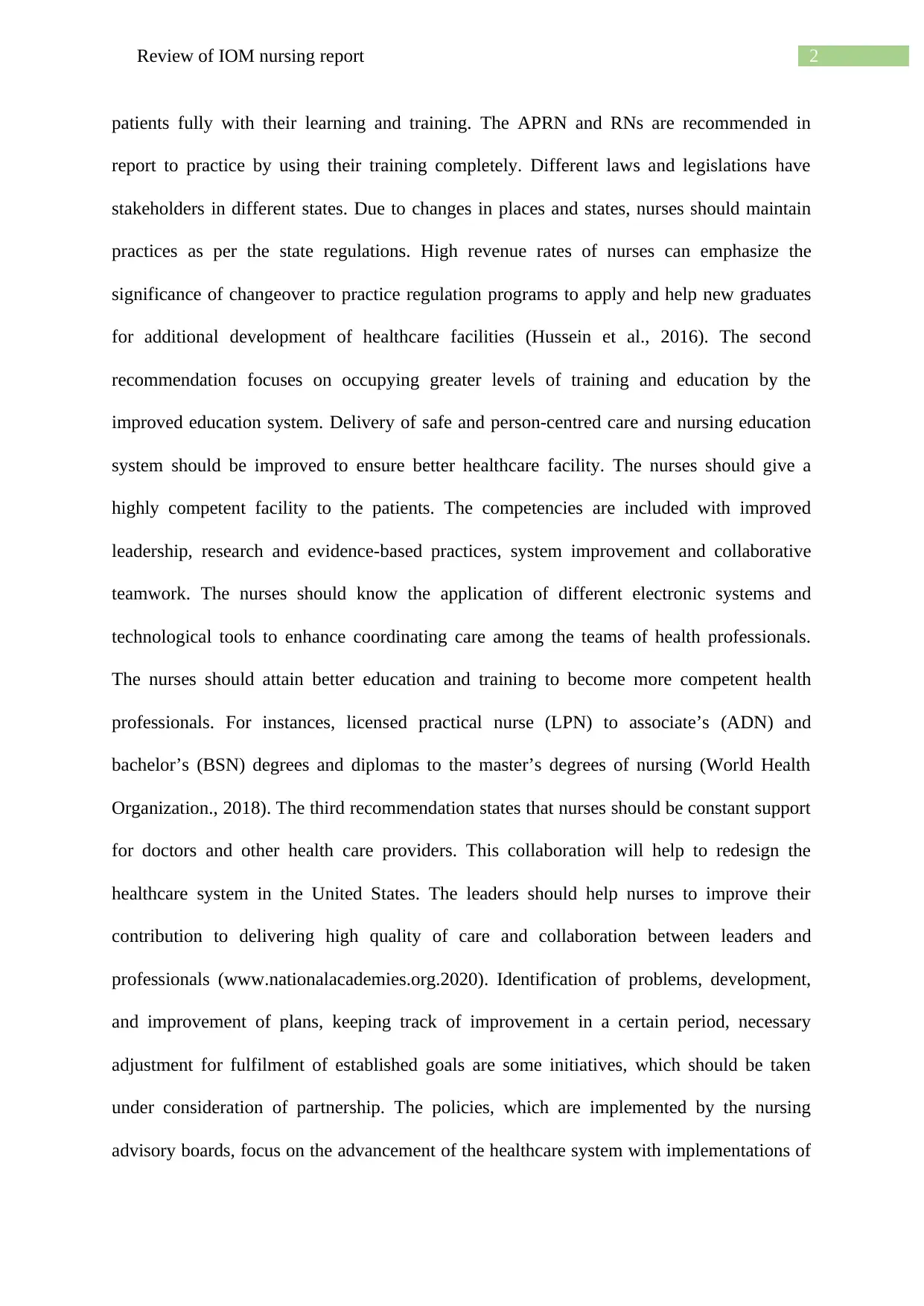
2Review of IOM nursing report
patients fully with their learning and training. The APRN and RNs are recommended in
report to practice by using their training completely. Different laws and legislations have
stakeholders in different states. Due to changes in places and states, nurses should maintain
practices as per the state regulations. High revenue rates of nurses can emphasize the
significance of changeover to practice regulation programs to apply and help new graduates
for additional development of healthcare facilities (Hussein et al., 2016). The second
recommendation focuses on occupying greater levels of training and education by the
improved education system. Delivery of safe and person-centred care and nursing education
system should be improved to ensure better healthcare facility. The nurses should give a
highly competent facility to the patients. The competencies are included with improved
leadership, research and evidence-based practices, system improvement and collaborative
teamwork. The nurses should know the application of different electronic systems and
technological tools to enhance coordinating care among the teams of health professionals.
The nurses should attain better education and training to become more competent health
professionals. For instances, licensed practical nurse (LPN) to associate’s (ADN) and
bachelor’s (BSN) degrees and diplomas to the master’s degrees of nursing (World Health
Organization., 2018). The third recommendation states that nurses should be constant support
for doctors and other health care providers. This collaboration will help to redesign the
healthcare system in the United States. The leaders should help nurses to improve their
contribution to delivering high quality of care and collaboration between leaders and
professionals (www.nationalacademies.org.2020). Identification of problems, development,
and improvement of plans, keeping track of improvement in a certain period, necessary
adjustment for fulfilment of established goals are some initiatives, which should be taken
under consideration of partnership. The policies, which are implemented by the nursing
advisory boards, focus on the advancement of the healthcare system with implementations of
patients fully with their learning and training. The APRN and RNs are recommended in
report to practice by using their training completely. Different laws and legislations have
stakeholders in different states. Due to changes in places and states, nurses should maintain
practices as per the state regulations. High revenue rates of nurses can emphasize the
significance of changeover to practice regulation programs to apply and help new graduates
for additional development of healthcare facilities (Hussein et al., 2016). The second
recommendation focuses on occupying greater levels of training and education by the
improved education system. Delivery of safe and person-centred care and nursing education
system should be improved to ensure better healthcare facility. The nurses should give a
highly competent facility to the patients. The competencies are included with improved
leadership, research and evidence-based practices, system improvement and collaborative
teamwork. The nurses should know the application of different electronic systems and
technological tools to enhance coordinating care among the teams of health professionals.
The nurses should attain better education and training to become more competent health
professionals. For instances, licensed practical nurse (LPN) to associate’s (ADN) and
bachelor’s (BSN) degrees and diplomas to the master’s degrees of nursing (World Health
Organization., 2018). The third recommendation states that nurses should be constant support
for doctors and other health care providers. This collaboration will help to redesign the
healthcare system in the United States. The leaders should help nurses to improve their
contribution to delivering high quality of care and collaboration between leaders and
professionals (www.nationalacademies.org.2020). Identification of problems, development,
and improvement of plans, keeping track of improvement in a certain period, necessary
adjustment for fulfilment of established goals are some initiatives, which should be taken
under consideration of partnership. The policies, which are implemented by the nursing
advisory boards, focus on the advancement of the healthcare system with implementations of
⊘ This is a preview!⊘
Do you want full access?
Subscribe today to unlock all pages.

Trusted by 1+ million students worldwide
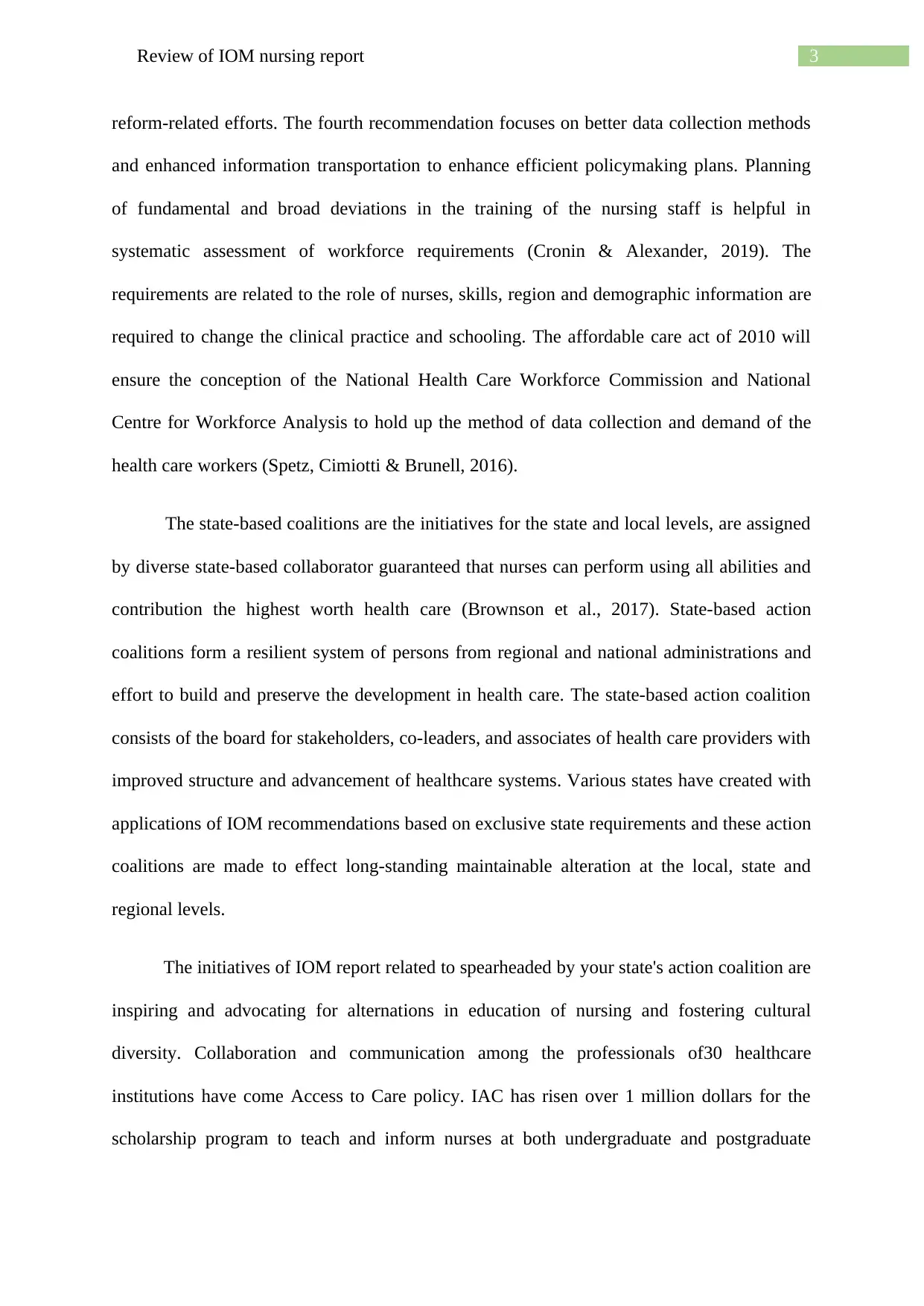
3Review of IOM nursing report
reform-related efforts. The fourth recommendation focuses on better data collection methods
and enhanced information transportation to enhance efficient policymaking plans. Planning
of fundamental and broad deviations in the training of the nursing staff is helpful in
systematic assessment of workforce requirements (Cronin & Alexander, 2019). The
requirements are related to the role of nurses, skills, region and demographic information are
required to change the clinical practice and schooling. The affordable care act of 2010 will
ensure the conception of the National Health Care Workforce Commission and National
Centre for Workforce Analysis to hold up the method of data collection and demand of the
health care workers (Spetz, Cimiotti & Brunell, 2016).
The state-based coalitions are the initiatives for the state and local levels, are assigned
by diverse state-based collaborator guaranteed that nurses can perform using all abilities and
contribution the highest worth health care (Brownson et al., 2017). State-based action
coalitions form a resilient system of persons from regional and national administrations and
effort to build and preserve the development in health care. The state-based action coalition
consists of the board for stakeholders, co-leaders, and associates of health care providers with
improved structure and advancement of healthcare systems. Various states have created with
applications of IOM recommendations based on exclusive state requirements and these action
coalitions are made to effect long-standing maintainable alteration at the local, state and
regional levels.
The initiatives of IOM report related to spearheaded by your state's action coalition are
inspiring and advocating for alternations in education of nursing and fostering cultural
diversity. Collaboration and communication among the professionals of30 healthcare
institutions have come Access to Care policy. IAC has risen over 1 million dollars for the
scholarship program to teach and inform nurses at both undergraduate and postgraduate
reform-related efforts. The fourth recommendation focuses on better data collection methods
and enhanced information transportation to enhance efficient policymaking plans. Planning
of fundamental and broad deviations in the training of the nursing staff is helpful in
systematic assessment of workforce requirements (Cronin & Alexander, 2019). The
requirements are related to the role of nurses, skills, region and demographic information are
required to change the clinical practice and schooling. The affordable care act of 2010 will
ensure the conception of the National Health Care Workforce Commission and National
Centre for Workforce Analysis to hold up the method of data collection and demand of the
health care workers (Spetz, Cimiotti & Brunell, 2016).
The state-based coalitions are the initiatives for the state and local levels, are assigned
by diverse state-based collaborator guaranteed that nurses can perform using all abilities and
contribution the highest worth health care (Brownson et al., 2017). State-based action
coalitions form a resilient system of persons from regional and national administrations and
effort to build and preserve the development in health care. The state-based action coalition
consists of the board for stakeholders, co-leaders, and associates of health care providers with
improved structure and advancement of healthcare systems. Various states have created with
applications of IOM recommendations based on exclusive state requirements and these action
coalitions are made to effect long-standing maintainable alteration at the local, state and
regional levels.
The initiatives of IOM report related to spearheaded by your state's action coalition are
inspiring and advocating for alternations in education of nursing and fostering cultural
diversity. Collaboration and communication among the professionals of30 healthcare
institutions have come Access to Care policy. IAC has risen over 1 million dollars for the
scholarship program to teach and inform nurses at both undergraduate and postgraduate
Paraphrase This Document
Need a fresh take? Get an instant paraphrase of this document with our AI Paraphraser
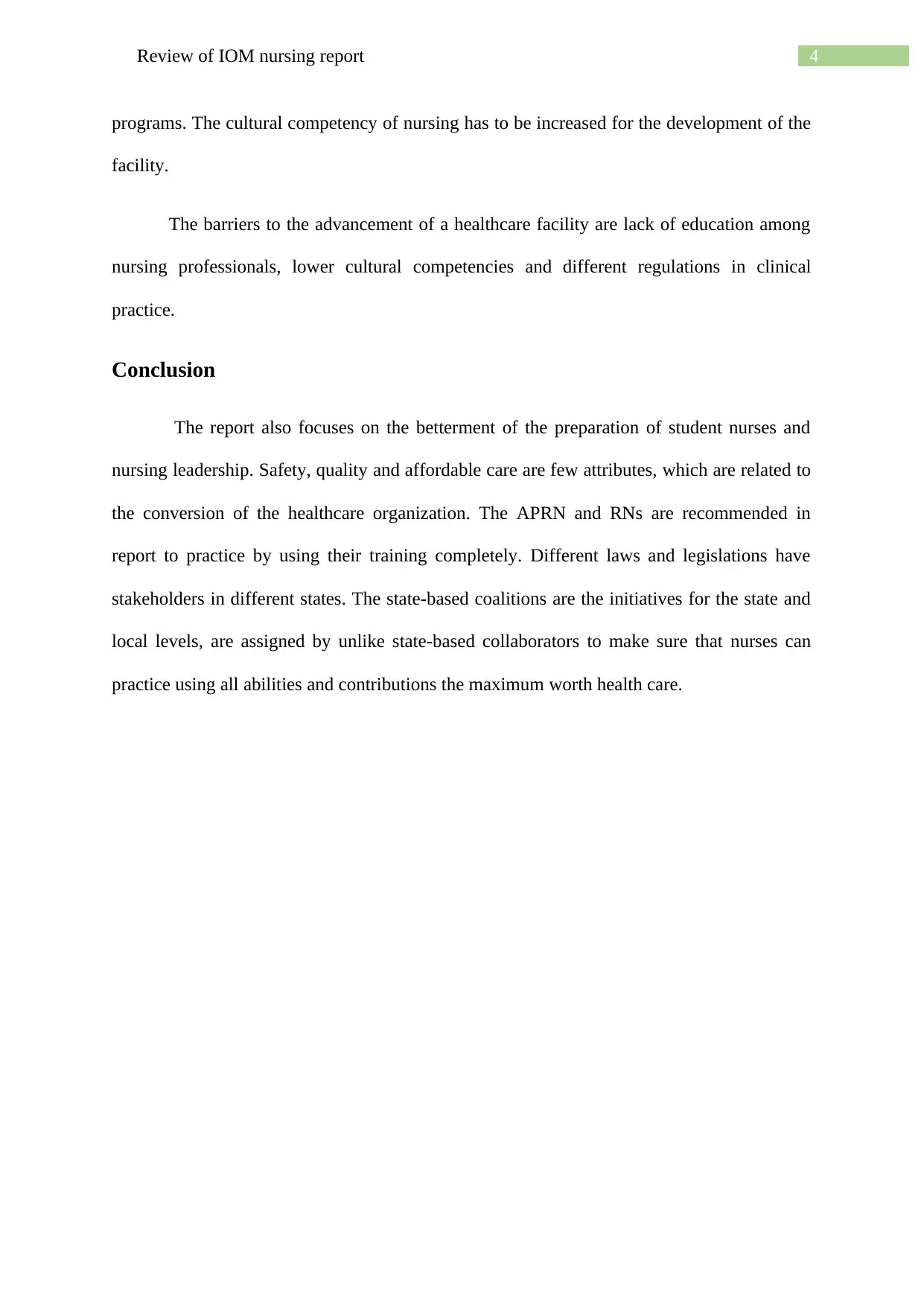
4Review of IOM nursing report
programs. The cultural competency of nursing has to be increased for the development of the
facility.
The barriers to the advancement of a healthcare facility are lack of education among
nursing professionals, lower cultural competencies and different regulations in clinical
practice.
Conclusion
The report also focuses on the betterment of the preparation of student nurses and
nursing leadership. Safety, quality and affordable care are few attributes, which are related to
the conversion of the healthcare organization. The APRN and RNs are recommended in
report to practice by using their training completely. Different laws and legislations have
stakeholders in different states. The state-based coalitions are the initiatives for the state and
local levels, are assigned by unlike state-based collaborators to make sure that nurses can
practice using all abilities and contributions the maximum worth health care.
programs. The cultural competency of nursing has to be increased for the development of the
facility.
The barriers to the advancement of a healthcare facility are lack of education among
nursing professionals, lower cultural competencies and different regulations in clinical
practice.
Conclusion
The report also focuses on the betterment of the preparation of student nurses and
nursing leadership. Safety, quality and affordable care are few attributes, which are related to
the conversion of the healthcare organization. The APRN and RNs are recommended in
report to practice by using their training completely. Different laws and legislations have
stakeholders in different states. The state-based coalitions are the initiatives for the state and
local levels, are assigned by unlike state-based collaborators to make sure that nurses can
practice using all abilities and contributions the maximum worth health care.
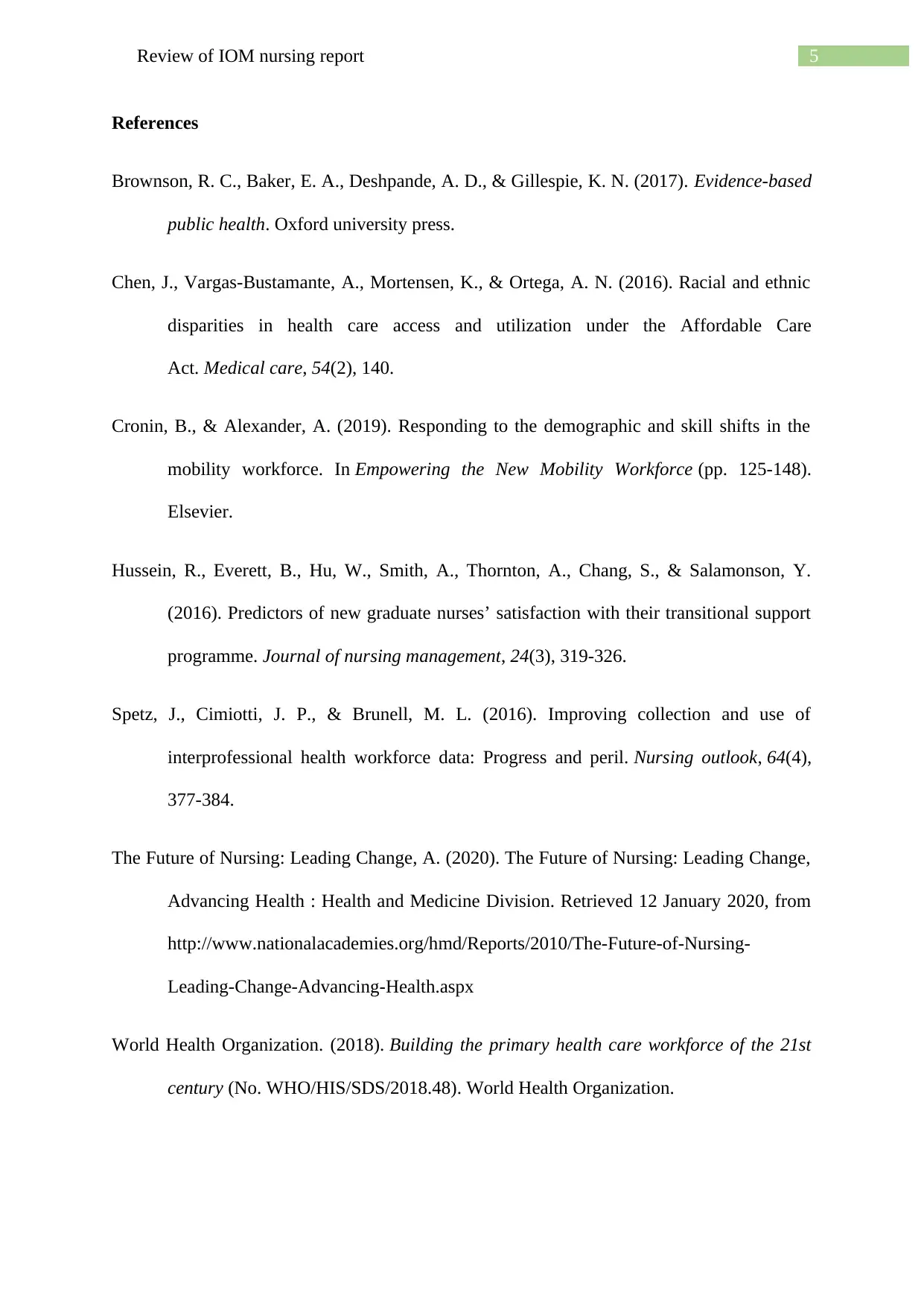
5Review of IOM nursing report
References
Brownson, R. C., Baker, E. A., Deshpande, A. D., & Gillespie, K. N. (2017). Evidence-based
public health. Oxford university press.
Chen, J., Vargas-Bustamante, A., Mortensen, K., & Ortega, A. N. (2016). Racial and ethnic
disparities in health care access and utilization under the Affordable Care
Act. Medical care, 54(2), 140.
Cronin, B., & Alexander, A. (2019). Responding to the demographic and skill shifts in the
mobility workforce. In Empowering the New Mobility Workforce (pp. 125-148).
Elsevier.
Hussein, R., Everett, B., Hu, W., Smith, A., Thornton, A., Chang, S., & Salamonson, Y.
(2016). Predictors of new graduate nurses’ satisfaction with their transitional support
programme. Journal of nursing management, 24(3), 319-326.
Spetz, J., Cimiotti, J. P., & Brunell, M. L. (2016). Improving collection and use of
interprofessional health workforce data: Progress and peril. Nursing outlook, 64(4),
377-384.
The Future of Nursing: Leading Change, A. (2020). The Future of Nursing: Leading Change,
Advancing Health : Health and Medicine Division. Retrieved 12 January 2020, from
http://www.nationalacademies.org/hmd/Reports/2010/The-Future-of-Nursing-
Leading-Change-Advancing-Health.aspx
World Health Organization. (2018). Building the primary health care workforce of the 21st
century (No. WHO/HIS/SDS/2018.48). World Health Organization.
References
Brownson, R. C., Baker, E. A., Deshpande, A. D., & Gillespie, K. N. (2017). Evidence-based
public health. Oxford university press.
Chen, J., Vargas-Bustamante, A., Mortensen, K., & Ortega, A. N. (2016). Racial and ethnic
disparities in health care access and utilization under the Affordable Care
Act. Medical care, 54(2), 140.
Cronin, B., & Alexander, A. (2019). Responding to the demographic and skill shifts in the
mobility workforce. In Empowering the New Mobility Workforce (pp. 125-148).
Elsevier.
Hussein, R., Everett, B., Hu, W., Smith, A., Thornton, A., Chang, S., & Salamonson, Y.
(2016). Predictors of new graduate nurses’ satisfaction with their transitional support
programme. Journal of nursing management, 24(3), 319-326.
Spetz, J., Cimiotti, J. P., & Brunell, M. L. (2016). Improving collection and use of
interprofessional health workforce data: Progress and peril. Nursing outlook, 64(4),
377-384.
The Future of Nursing: Leading Change, A. (2020). The Future of Nursing: Leading Change,
Advancing Health : Health and Medicine Division. Retrieved 12 January 2020, from
http://www.nationalacademies.org/hmd/Reports/2010/The-Future-of-Nursing-
Leading-Change-Advancing-Health.aspx
World Health Organization. (2018). Building the primary health care workforce of the 21st
century (No. WHO/HIS/SDS/2018.48). World Health Organization.
⊘ This is a preview!⊘
Do you want full access?
Subscribe today to unlock all pages.

Trusted by 1+ million students worldwide
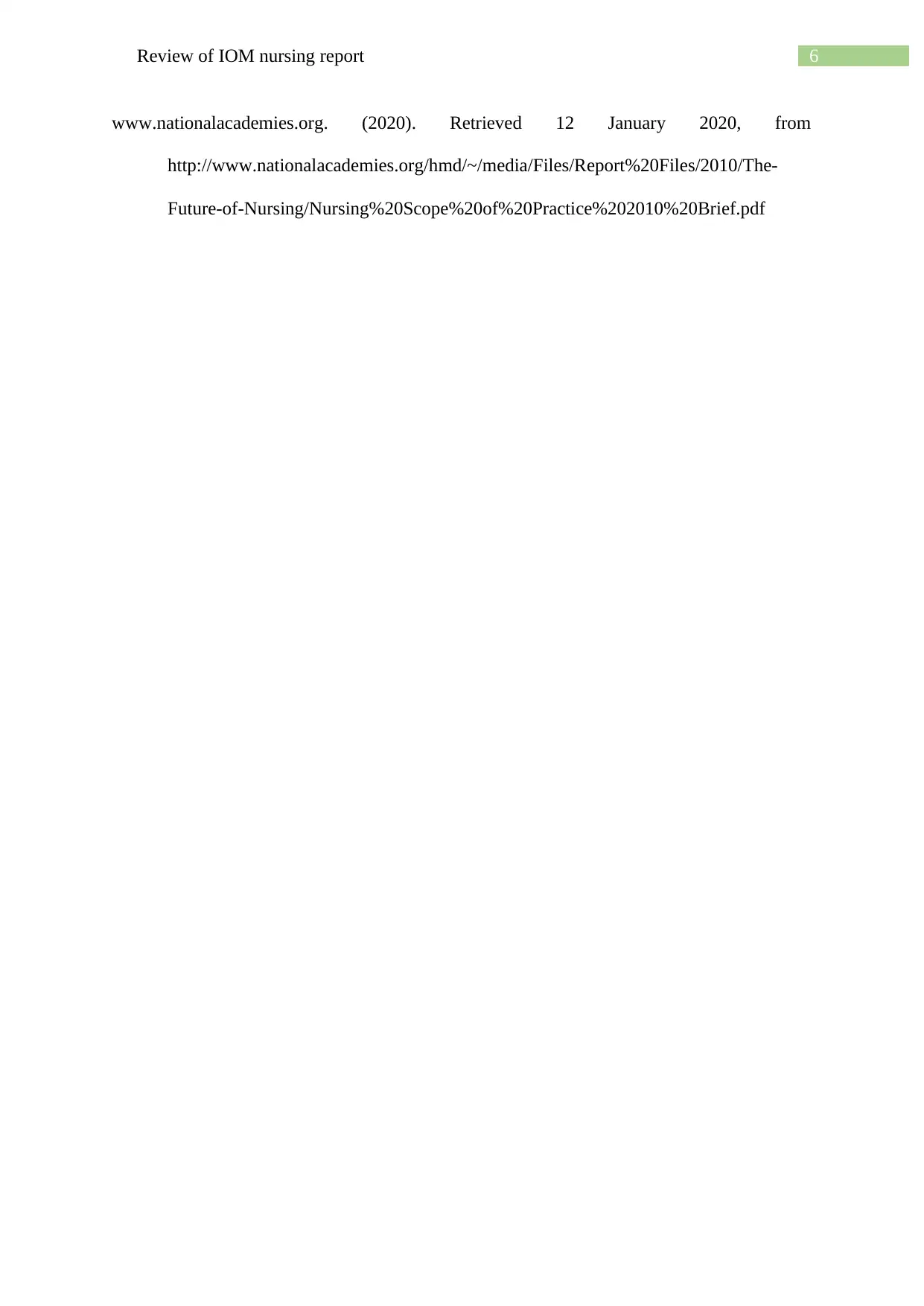
6Review of IOM nursing report
www.nationalacademies.org. (2020). Retrieved 12 January 2020, from
http://www.nationalacademies.org/hmd/~/media/Files/Report%20Files/2010/The-
Future-of-Nursing/Nursing%20Scope%20of%20Practice%202010%20Brief.pdf
www.nationalacademies.org. (2020). Retrieved 12 January 2020, from
http://www.nationalacademies.org/hmd/~/media/Files/Report%20Files/2010/The-
Future-of-Nursing/Nursing%20Scope%20of%20Practice%202010%20Brief.pdf
1 out of 7
Related Documents
Your All-in-One AI-Powered Toolkit for Academic Success.
+13062052269
info@desklib.com
Available 24*7 on WhatsApp / Email
![[object Object]](/_next/static/media/star-bottom.7253800d.svg)
Unlock your academic potential
Copyright © 2020–2025 A2Z Services. All Rights Reserved. Developed and managed by ZUCOL.





